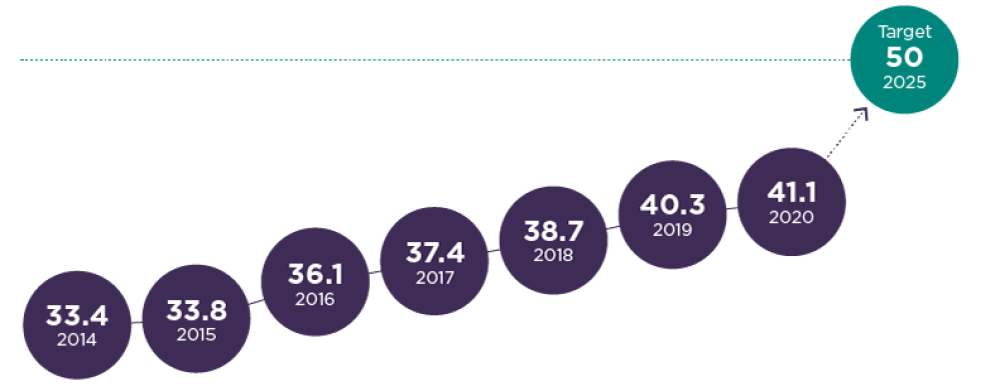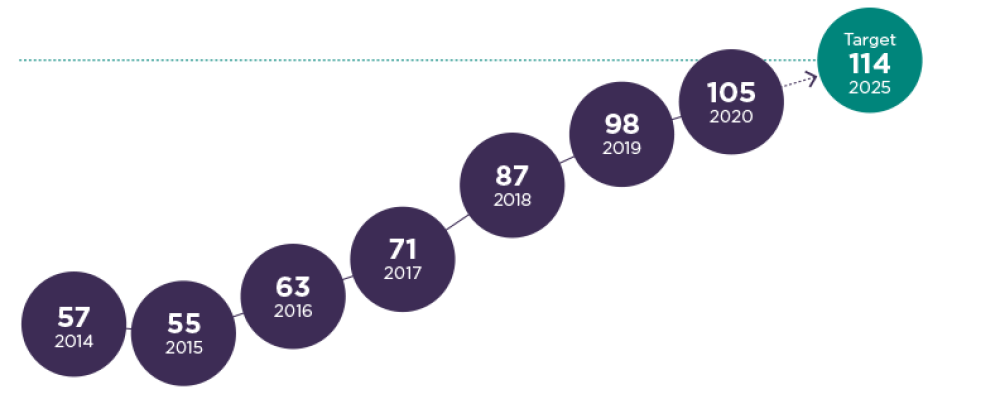3,333
senior executives in the government sector
A key objective of the Government Sector Employment Act 2013 (GSE Act) was to create a simpler executive structure that enables greater mobility of this cohort across the sector. The Government Sector Employment Legislation Amendment Act 2016 supported this work by aligning the Senior Executive employment arrangements of the NSW Health Service, Transport Service and NSW Police Force with those of the Public Service.
Table 3.1: Senior executives in the public sector, census headcount, 2019–20
| Service | 2019 | 2020 | Change (%) |
|---|---|---|---|
| Public Service | 2,140 | 2,098 | -2.0 |
| NSW Health Service | 181 | 188 | 3.9 |
| NSW Police Force | 69 | 74 | 7.2 |
| Teaching Service | 0 | 0 | 0.0 |
| Transport Service | 588 | 675 | 14.8 |
| Other Crown services | 278 | 298 | 7.2 |
| Total government sector | 3,256 | 3,333 | 2.4 |
| State owned corporations | 241 | 243 | 0.8 |
| External to government sector | 53 | 61 | 15.1 |
| Total public sector | 3,550 | 3,637 | 2.5 |
At June 2020, there were 3,637 senior executives in the public sector, with 3,333 in the government sector.
This is an increase of 2.5% compared to the previous year. Increases occurred across all services other than the Public Service. The largest increase was in the Transport Service (87). Transport for NSW confirmed that the majority of this increase related to resourcing for infrastructure projects such as motorways. Sydney Metro contributed around a third of the increase (28) to support the launch of new Metro projects.
There was a 2% decrease in senior executive numbers in the Public Service, reflecting an initiative to reduce the cohort, which was implemented on 30 June 2019 (see Figure 3.1).
Table 3.2: Senior executives in the Public Service by cluster, census headcount, 2019–2020
| Cluster | 2019 | 2020 | Change | Change (%) |
|---|---|---|---|---|
| Customer Service | 273 | 254 | -19 | -7.0 |
| Education | 348 | 372 | 24 | 6.9 |
| Health | 101 | 116 | 15 | 14.9 |
| Planning, Industry and Environment | 575 | 436 | -139 | -24.2 |
| Regional NSW | - | 143 | - | - |
| Premier and Cabinet | 257 | 240 | -17 | -6.6 |
| Stronger Communities | 437 | 388 | -49 | -11.2 |
| Transport | 1 | 1 | 0 | 0.0 |
| Treasury | 148 | 148 | 0 | 0.0 |
| Total public sector | 2,140 | 2,098 | -42 | -2.0 |
Table 3.2 shows that reductions occurred in four clusters. Excluding machinery of government changes, the largest reduction occurred in the Stronger Communities cluster (-49). The reduction in senior executives in the Planning, Industry and Environment cluster was a result of the separation of Regional NSW to form a new department and cluster.
Figure 3.2 shows that in 2020, 78.1% of Public Service senior executives (PSSEs) and aligned services senior executives were classified as Senior Executive Band 1, while 17.6% fell into Band 2 and only 4.3% into Band 3. The distribution of PSSEs and aligned services senior executives between bands is similar, with 77.5% of PSSEs and 79.2% of aligned services senior executives at Band 1, and 4.5% and 4.0% at Band 3, respectively.
Premier’s Priority for diversity in the senior leader cohort
Percentage of female senior leaders

| 2014 | 2015 | 2016 | 2017 | 2018 | 2019 | 2020 |
| 33.4% | 33.8% | 36.1% | 37.4% | 38.7% | 40.3% | 41.1% |
Target: 50% by 2025
Number of Aboriginal and Torres Strait Islander senior leaders

| 2014 | 2015 | 2016 | 2017 | 2018 | 2019 | 2020 |
| 57 | 55 | 63 | 71 | 87 | 98 | 105 |
Target: 114 by 2025
One of the components of the Premier’s Priority for a world class public service is driving senior leader diversity. The priority includes targets to achieve gender equity in senior leaders and increase the number of Aboriginal and Torres Strait Islander people in senior leadership roles by 2025.
Steady progress has been made towards achieving these targets since the priority was announced in 2014. The proportion of female senior leaders increased by 0.8 percentage points (pp) to 41.1% in 2020.
Female representation in each band has largely increased each year, and cumulatively is up by 7.3pp for Band 1 senior leaders, 11.2pp for Band 2 and 14.0pp for Bands 3 and 4 since 2014.1 Women have lower representation than men in higher salary bands, but the gap has narrowed since the target was introduced. Since 2016, the proportion of female leaders in Bands 3 and 4 combined has increased at approximately double the rate of Band 1 roles.
Table 3.3: Female senior leaders by equivalent band, 2014–20201
| 2014 (%) | 2015 (%) | 2016 (%) | 2017 (%) | 2018 (%) | 2019 (%) | 2020 (%) | |
|---|---|---|---|---|---|---|---|
| Band 1 | 33.9 | 34.4 | 36.6 | 37.7 | 38.8 | 40.5 | 41.2 |
| Band 2 | 30.9 | 31.2 | 35.0 | 37.4 | 40.5 | 40.3 | 42.1 |
| Bands 3 and 4 | 22.2 | 20.8 | 24.8 | 28.3 | 30.6 | 34.6 | 36.2 |
| Total | 33.4 | 33.8 | 36.1 | 37.4 | 38.7 | 40.3 | 41.1 |
Female senior leader representation varies across clusters (see Table 3.4). In this table, 2019 data are displayed in the 2020 cluster structure. No result is displayed for Regional NSW in 2019 because these data cannot be accurately mapped.
Table 3.4: Female senior leaders by cluster, 2019–20201
| Cluster | 2019 (%) | 2020 (%) |
|---|---|---|
| Customer Service | 52.6 | 49.9 |
| Education | 54.8 | 56.0 |
| Health | 41.6 | 43.1 |
| Planning, Industry and Environment | 37.9 | 46.5 |
| Premier and Cabinet | 55.0 | 52.9 |
| Regional NSW | - | 27.7 |
| Stronger Communities | 29.8 | 29.5 |
| Transport | 30.3 | 32.2 |
| Treasury | 45.6 | 45.4 |
| Total government sector | 40.3 | 41.1 |
The Education and Premier and Cabinet clusters have more than 50% female representation (56% and 52.9%, respectively) and Customer Service is close to the target with 49.9%. While the Transport cluster has one of the lowest rates, it improved representation by close to 2pp in 2020.
Further improvements are needed if the sector is to reach its target in 2025. Based on turnover and gender ratios, forecasting shows that if the current trends continue there will be a 7% shortfall on reaching the target. Modelling indicates that the NSW Government could reach the target by 2025 if six in every 10 senior leader appointments are female.
The number of Aboriginal and Torres Strait Islander senior leaders increased between 2019 and 2020, from 98 to 105. The Health, Stronger Communities, and Planning, Industry and Environment clusters accounted for most of the increase. Apart from a slight decrease in 2015, the number of Aboriginal and Torres Strait Islander senior leaders has increased each year since 2014, with the total increase at 84.2%.
Table 3.5: Aboriginal and Torres Strait Islander senior leaders by band, census headcount, 2014–20201
| 2014 | 2015 | 2016 | 2017 | 2018 | 2019 | 2020 | |
|---|---|---|---|---|---|---|---|
| Band 1 | 52 | 51 | 57 | 63 | 78 | 88 | 97 |
| Bands 2, 3 and 4 | 5 | 4 | 6 | 8 | 9 | 10 | 8 |
| Total | 57 | 55 | 63 | 71 | 87 | 98 | 105 |
Figure 3.4 highlights that while most of the increase in the Aboriginal and Torres Strait Islander cohort occurred in the lower salary range (45 appointments), the number of Aboriginal and Torres Strait Islander senior leaders in Senior Executive Bands 2–4 has increased by three since 2014. Significant progress has been made towards reaching the target of doubling the representation of Aboriginal and Torres Strait Islander people. If the current rate of increase continues, this target will be achieved by 2022.
Notes
1 Senior leaders are non-casual government sector employees earning $165,750 or more (adjusted annually according to wages policy), excluding NSW Health Service roles of a specialist or technical nature with no leadership or managerial responsibilities, and Justice roles of a statutory or institutional character (judges, magistrates and barristers). When displayed in bands, these align to the salary ranges of PSSEs, and Band 1 includes non‑executives paid below the minimum PSSE salary level.
- Next chapter
Types of work